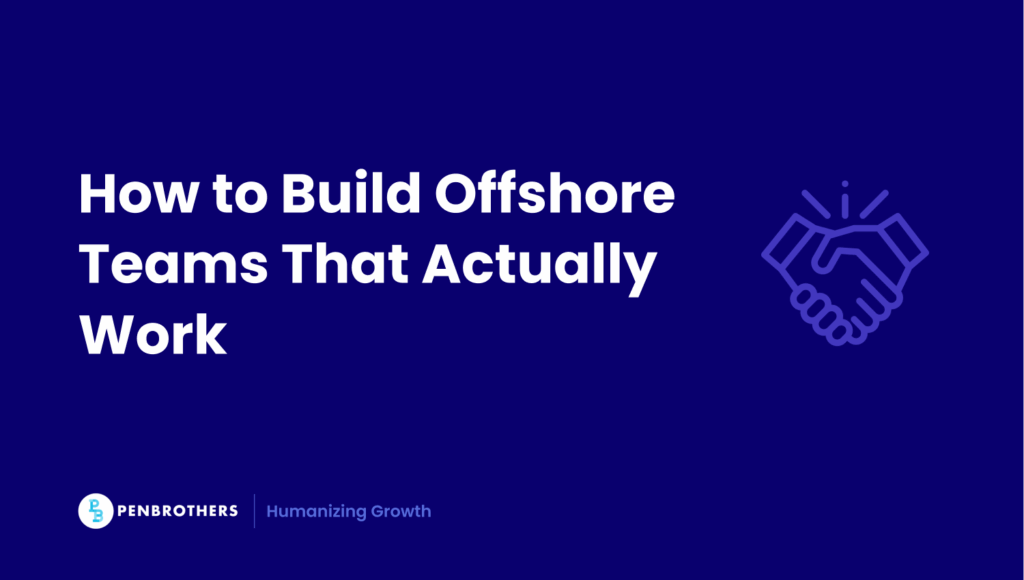The global hiring market is broken. Finding the right talent is no longer just hard, it’s expensive, time-consuming, and frustratingly inefficient. Companies are spending more only to wait longer. The result? Talent bottlenecks that stall growth.
Offshore hiring has surged as a solution to this. But most companies still get it wrong. They chase cost savings. They plug into cookie-cutter vendors. They treat talent like transactions, not people.
This article is for founders, HR leaders, COOs, and CFOs who want to get offshore hiring right. Not as a cost play, but as a long-term strategic move.
Why Offshore Hiring Now?
Let’s start with what’s changed.
- Massive global talent gaps: Korn Ferry’s Global Talent Crunch study projects a shortfall of more than 85 million skilled professionals by 2030, equivalent to the population of Germany, risking about USD 8.5 trillion in unrealized revenue.
- Rising domestic costs: According to the U.S. Bureau of Labor Statistics, average hourly earnings for private-sector workers reached $36.24 in May 2025, reflecting continued upward pressure on labor costs.
- Time-to-hire pressures: According to LinkedIn’s Economic Graph data, the median time-to-hire for engineering roles in North America is 49 days, the longest among all job functions.
Offshore hiring is no longer just about lowering payroll. It’s about unlocking access to ready, skilled, and scalable talent pools. Explore how smart companies are building long-term offshoring strategies.
The Trouble with Transactional Offshoring
The typical outsourcing model looks like this:
- A vendor promises “fast and cheap.”
- Candidates appear quickly.
- There’s no onboarding.
- There are no real relationships.
Here’s what happens next:
- Turnover increases because the team feels disconnected.
- Quality drops as expectations were never clearly aligned.
- Accountability vanishes because no one owns the outcome.
Transactional offshoring leads to short-term wins and long-term dysfunction. It also leads to what founders fear most: team fragmentation.
You need more than just a provider. You need a partner.
The Case for a True Offshore Partnership
A real offshore partner doesn’t just fill seats. They build team extensions that last.
Here’s what that looks like:
- Strategic alignment: They don’t just respond to job descriptions. They understand the why behind every hire, connecting talent strategy with your long-term roadmap.
- Two-way communication: It’s not just status updates. There’s real transparency. Challenges are surfaced early. Solutions are co-owned.
- Shared KPIs: Your offshore team is measured by the same yardstick as your local one. No silos. No shortcuts.
- Cultural integration: Your offshore talent doesn’t feel like a separate unit. They join team huddles, celebrate wins, and live your values day-to-day.
At Penbrothers, this is what we commit to through our Hypercare Framework, a structured onboarding and support model designed to help offshore hires thrive not just in week one, but well into the first 90 days and beyond.
Because offshore hiring isn’t just a transaction. It’s a relationship. Want to see how an Offshore Development Center can be structured around your business? Here’s how to build one right.
What Success Looks Like: Offshore Hiring Done Right
When it works, offshore hiring isn’t just efficient. It’s transformative.
Here’s what companies get:
Faster hiring cycles
Global talent sourcing drastically reduces time-to-fill, especially for high-demand roles in engineering, marketing, design, and support. While local hiring may take 40–50 days, offshore pipelines can shorten that timeline by weeks, keeping growth initiatives on track.
Lower team burnout
With the right offshore support, internal teams can offload operational strain and avoid the kind of overwork that leads to churn. Offshore hiring becomes a buffer against burnout, not just a budget line item.
Operational scalability
Need to scale your CS team for peak season? Launching a new product that needs design and dev support fast? Offshore teams allow you to flex up or down with near-zero friction, no local hiring bottlenecks or long-term overhead commitments.
Higher retention
When offshore talent is embedded, empowered, and supported, they stay longer and contribute more deeply. True partners invest in engagement and growth, not just placement.
Tangible ROI
According to Deloitte’s 2023 Shared Services and Outsourcing Survey reports that almost 90% of organizations cite cost reduction as the main benefit of offshore models but notably, over 70% also noted improved service quality from their offshore teams.
But these outcomes depend on one thing. Choosing the right partner.
Red Flags: When Your Offshore “Partner” Isn’t One
Many companies don’t know they’re in a bad offshore relationship. Until it’s too late.
Here are signs your partner might be a vendor, not an ally:
They never ask about your long-term goals
A true partner starts with the bigger picture, your company vision, growth plans, and success metrics. If your offshore provider jumps straight into filling roles without understanding why those roles matter or how they tie into your strategy, they’re not building a team, they’re filling a quota. This short-term mindset leads to mismatches in skills, priorities, and expectations down the line.
There’s no structured onboarding
Dropping a new offshore hire into your workflow without proper onboarding is like handing someone a parachute and hoping they figure it out on the way down. A reliable partner takes ownership of onboarding, from tech setup and training to culture alignment and process clarity. If your hires are left guessing how to contribute or where they fit, performance will suffer, no matter how talented they are.
You manage everything alone
Offshore hiring should lighten your load, not add to it. If you’re chasing updates, resolving conflicts, and managing retention solo, your provider is failing you. A real partner supports you with embedded team leads, clear escalation paths, and proactive check-ins. Without that, you’re not getting a service, you’re being handed a responsibility.
They avoid transparency
When a provider resists sharing performance data, retention insights, or process feedback, that’s a red flag. You deserve visibility. From day-to-day productivity to long-term engagement, a partner should be offering dashboards, pulse checks, and regular reporting. If you’re left in the dark, you can’t optimize and you certainly can’t trust.
If any of this sounds familiar, it’s time to re-evaluate.
Offshore hiring done wrong can quietly drain productivity, morale, and trust.
Penbrothers’ Success Story
How Luxclusif Went from Bootstrapped to Acquired with Offshore TalentStory
When Luxclusif, a B2B platform for authenticated luxury goods, was bootstrapping, they needed to scale fast without overspending. They partnered with Penbrothers to build a lean offshore team in the Philippines, covering logistics, finance, and tech support. Penbrothers managed everything from hiring to compliance, allowing Luxclusif to focus on growth.
The results? A high-performing team, 78% average cost savings per role, and a setup that supported their eventual acquisition by Farfetch in 2021.
Making It Work: Best Practices for Offshore Partnerships
So how do you do it right?
Here’s what we’ve learned from supporting hundreds of teams at Penbrothers:
- Start with strategy: Don’t begin with job titles, begin with business outcomes. Define what success looks like for the role before you write the JD. Ask yourself: How does this role support growth, efficiency, or customer experience? When strategy leads, hiring becomes aligned, not reactive.
- Prioritize onboarding: Day one isn’t a checkbox, it’s a momentum builder. A structured onboarding process covering tools, goals, team norms, and communication expectations sets the tone for everything that follows. The first 30 days shape performance in the next 90.
- Design for integration: Offshore teams shouldn’t feel like outsiders. Invite them to daily standups, retros, Slack channels, and company-wide huddles. Involve them in team rituals, product reviews, and customer feedback loops. Integration is the difference between working with you vs. working for you.
- Establish strong communication cadences: Don’t leave clarity to chance. Create regular syncs, set response time expectations, and establish escalation paths. Daily or weekly check-ins help align priorities and surface blockers before they become problems.
- Assign a single point of contact: Distributed teams need centralized accountability. Whether it’s a team lead, delivery manager, or offshore success partner, one person should own the relationship. This simplifies feedback loops and ensures continuity even as the team grows.
- Invest in culture: Visibility, recognition, and inclusion don’t happen by default, they require intent. Celebrate wins, spotlight offshore contributions, and make space for informal connection. When offshore teams feel seen and valued, performance follows.
Hiring offshore doesn’t mean outsourcing culture. It means extending it.
Final Thoughts
We’ve seen what happens when offshore hiring is done right. Companies grow faster. Teams collaborate better. Founders sleep easier. Offshore hiring, when built on partnership, is no longer a workaround, it’s a competitive advantage. Forget the old model. Forget “outsourcing.” Think globally. Hire with intent. Build for the long haul. That’s offshore hiring done right. That’s what we do at Penbrothers.
Ready to build a high-performing offshore team that actually sticks? Let’s talk. We help fast-growing companies scale smarter, not just cheaper, through strategic partnerships, not transactions. Let’s talk!






